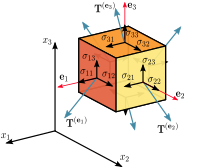
Photo from wikipedia
World Psychiatry 20:2 June 2021 can play permissive or suppressive roles in determining the magnitude of SNS stress reactivity. Because HPA axis functionality can precede and inform the nature of… Click to show full abstract
World Psychiatry 20:2 June 2021 can play permissive or suppressive roles in determining the magnitude of SNS stress reactivity. Because HPA axis functionality can precede and inform the nature of the sympathetic stress response, incorporating preceding levels of available cortisol in situ during moments of emotional strain may help to better calibrate measurements of SNS reactivity in dysphoric individuals. Moreover, it has been demonstrated that the doctrine of reciprocal antagonism between the PNS and SNS – the notion that more of one inherently means less of the other – does not universally hold. This conclusion dictates that the two systems can exhibit concurrent and interactive behavior and should be measured and modeled as separate and distinct dimensions. A systems approach to stress responsiveness may help to better define and measure the individual components. However, methodological challenges remain regarding the measurement and timing of different system components. The cascade of HPA axis hormonal actions has been well documented, with peak effects following roughly 20 min after stress exposure. Meanwhile, PNS effects such as vagal withdrawal can operate on a scale of milliseconds to seconds, and SNS effects typically take place on a scale of seconds to minutes. We propose that research into autonomic functioning in human subjects should be pursued via time series analysis of electrophysiological measurements. Common inputs such as respiratory sinus arrhythmia, preejection period, and heart rate can be binned in epochs as small as 30 sec. Thus, data collection periods as short as an hour can produce time series of 120 observations. Time series analyses such as vector-autoregression and network analysis can model the relationships between system components. Moreover, ambulatory technologies exist allowing researchers to capture autonomic functioning in emotionally salient scenarios during an individual’s day-to-day life. Measures such as pre-ejection period require academic-research-grade equipment and expertly placed electrodes. However, innovations in mobile assaying of salivary measures could yield ambulatory measurements of SNS markers such as salivary alpha-amylase. Additionally, one could foresee the development of a fingerstick system for capillary blood measurement of catecholamines akin to blood glucose monitoring systems. It has been shown that reliable measurements of catecholamines can be derived from as little as 100 μL of capillary blood. Understanding the role of the SNS in the treatment of depression may be important for patients’ psychological and physical health. As noted above, depressed individuals have been shown to have significantly decreased parasympathetic cardiac regulation, and depression has long been associated with an increased incidence of coronary heart disease. Although the evidence for sympathetic predominance in depressed patients has been equivocal, there is some evidence that antidepressant medications may affect this predominance. Of note, one study has found that cognitive behavioral treatment may increase heart rate variability. Clearly, more work is needed to understand the effects of psychotherapy and antidepressant medications on the SNS and sympathetic cardiac control. Finally, we noted at the outset the likely existence of heterogeneous subpopulations of depressed individuals, some of whom may experience elevations in sympathetic arousal and some may not. It follows that individuals could exhibit more complex individual differences in the calibration of stress responsivity among cognitive, affective and physiological system components. From this perspective, the SNS could play a primary role in driving phenomenological and physiological consequences for some individuals. For instance, during the transduction of cognitive-emotional stimuli into physiological responses, an adrenergic gain factor might serve to amplify moderate signals into more robust responses. In a time series context, competing directional models of SNS arousal, subjective affect, and cognitive appraisal could be tested. Moreover, such evaluations could be carried out on a person-by-person basis. The SNS plays a calibrating role, exerting effects in response to shifting external demands and emotional conditions. It may be more fruitful to examine these dynamic, time-varying relationships with other stress-response systems, rather than mean group differences.
Journal Title: World Psychiatry
Year Published: 2021
Link to full text (if available)
Share on Social Media: Sign Up to like & get
recommendations!